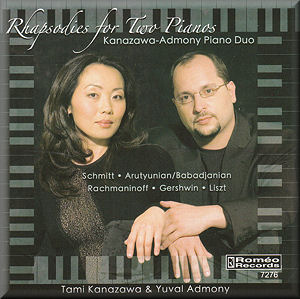 |
 |
|


alternatively
CD:
MDT
AmazonUK
AmazonUS
|
Rhapsodies for Two Pianos
Florent SCHMITT (1870-1958)
Three Rhapsodies (Française; Polonaise; Viennoise), Op.53 (1903-04) [21:06]
Alexander ARUTYUNIAN (b.1920) and
Arno BABADJANIAN (1921-1983)
Armenian Rhapsody (1950) [5:57]
Sergei RACHMANINOV (1873-1943)
Russian Rhapsody (1891) [9:45]
George GERSHWIN (1898-1937)
Rhapsody in Blue (1924) [17:21]
Franz (Ferenc) LISZT (1811-1886)
Hungarian Rhapsody No.2 (arr. Kleinmichel, cadenza by Yuval Admony) (1851) [10:28]
 Tami Kanazawa, Yuval Admony (piano)
Tami Kanazawa, Yuval Admony (piano)
rec. 2001(Schmitt)-2003, Rolston Recital Hall, Banff Centre for the Arts, Canada
 ROMÉO RECORDS 7276 [64:37]
ROMÉO RECORDS 7276 [64:37] 
|
|
|
There is some excellent playing here, but it took me some time
to warm to this disc. This was mostly due to the music that
opens the program, and takes about one third of its length:
three Rhapsodies by Florent Schmitt. Schmitt’s music
has experienced somewhat of a revival in the last few years,
and his name has started appearing in release lists. I happen
to know some of his music, and much of it is good. The composer
seems to have fallen in the pit between the pillars of Debussy
and Les Six, but if judged solely on the evidence of the three
works presented here, I’d say he had better stay forgotten in
this pit.
The three Rhapsodies are subtitled Française, Polonaise
and Viennoise, but they have neither enough diversity
nor national character to earn these labels. More or less, these
are three bourgeois Waltzes, with some salon melancholy and
salon comfort, and a lot of circus pomp and bravura. Don’t follow
the square tunes: there is little to follow there. If you want
to spend your time better, listen to the music that surrounds
the tune: some of the accompanying touches are quite intricate
and stimulating. There are episodes with soft, caressing harmonies,
and with glittering quicksilver runs; there are overblown Romantic
climaxes and hushed, elegiac moments. However the main musical
content is plain, and the melodies usually just rise up – and
go down, up – and down. Schmitt certainly gave a lot of work
to the pianists, and I am sure this can be great music to watch
– especially when performed with such poise and assurance.
Armenian folk music is very melodic, and some of its characteristic
twists and turns can be already familiar to you from Khachaturian’s
works. Two of his younger compatriots – Arutyunian and Babadjanian
– collaborated on the Armenian Rhapsody. The beginning
is slower and darker – like a ballad. The music goes higher
and louder, and the tension grows. After a short climax the
music calms down, and we move into the brisk and lively second
part. It brings to mind the main theme of the first movement
of Khachaturian’s violin concerto – with the same lightness
and fervor, insistent rhythmic pressure, and a similar nervous
“saw-teeth” melody. The music is memorable and, compared to
other works on this disc, seems too short. It comes, it rolls
past you – and is gone, like a swift dance.
The Russian Rhapsody of Rachmaninov was written when
the composer was just 18. It is essentially a set of variations
of increasing density. The theme is very Russian, and it seems
as if we have already heard it in some of Tchaikovsky’s music.
It is simple, but does not sound square, and provides a rich
base for variations. The strong influence of Tchaikovsky is
clearly felt, but there already is a lot of Rachmaninov’s forming
self, with its characteristic chanting and shimmer. The slow
variation is very beautiful. Kanazawa and Admony give an excellent
performance, worthy of the Russian piano school. Different performers
usually emphasize different traits in this music: Kanazawa and
Admony highlight its sunny, playful side.
Can one still enjoy Gershwin’s Rhapsody In Blue without
Grofé’s sparkling orchestration? Surprisingly, yes: the main
meat of this music, Gershwin’s rhythmic and melodic invention,
is still there. The composer said about this composition: “I
heard it as a sort of musical kaleidoscope of America, of our
vast melting pot, of our unduplicated national pep, of our metropolitan
madness”. It’s all present in the two-piano arrangement – though
it is hard to be without the famous opening clarinet glissando,
or without all the wild orchestral tutti that we have
become accustomed to. The playing is brilliant, though at the
same time it seems a bit over-cautious. Maybe a more unbuttoned
performance would better suit this brave new music. The “love
theme” is wide and expressive, but outside it there is much
hard staccato. Still, I was left with an overwhelming
cinematographic feeling, just as after a good performance of
the orchestral version. It’s the longest work on the disk, but
it just flies by effortlessly.
The pianists show excellent synchronization in Liszt’s famous
Hungarian Rhapsody No.2. In its ever-changing tempos
they navigate as one living organism. The performance has all
the necessary bravura and is technically very impressive. It
is grand and childish exactly where needed. The cimbalom effects
are well done. Again, it sounds too staccato to my taste,
as if the pianists played it with mallets, not fingers. Also,
here, as in other works, they are a little let down by the rather
shallow and uninteresting piano sound.
I do not know who wrote the liner-note, but it is informative
and engaging. It mostly speaks about the works present on the
disk, on a rather accessible level. The recording quality is
good and clear, but lacks some depth. As a whole, this is an
interesting collection – though at some point I started skipping
over the Schmitt pieces; I just can’t take the whole 20 minutes
of golden oompah. The performance tends to be percussive, which
is good for some works, less so for others.
Oleg Ledeniov
|
|

